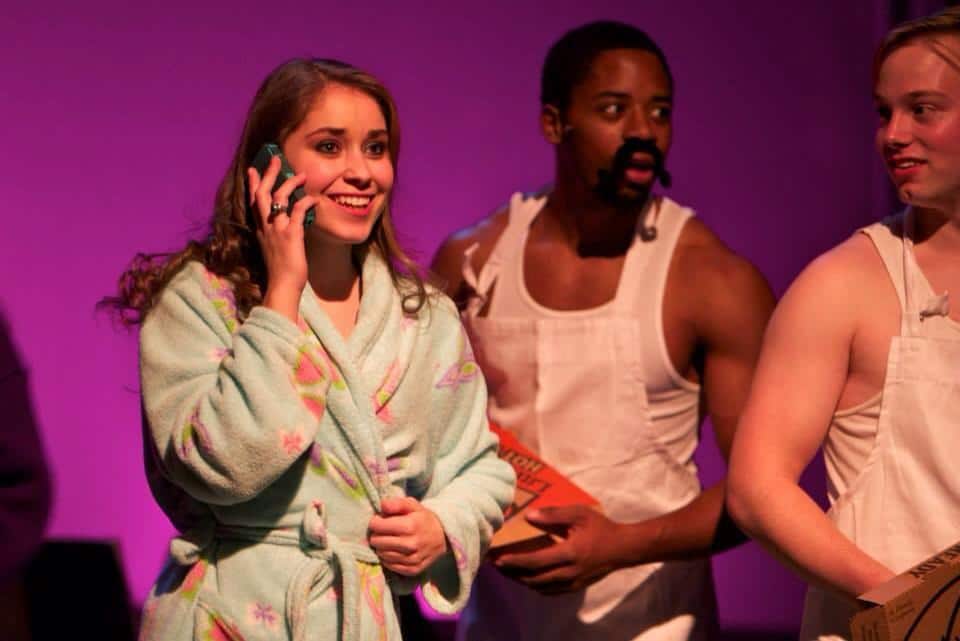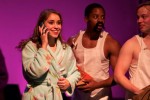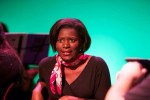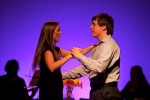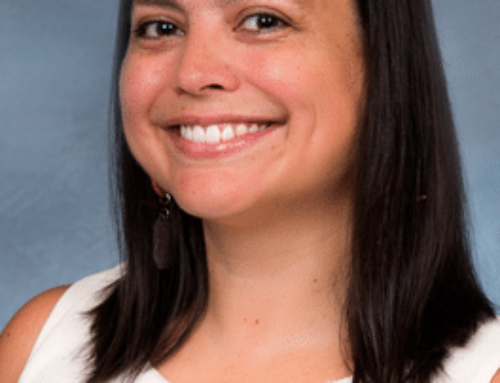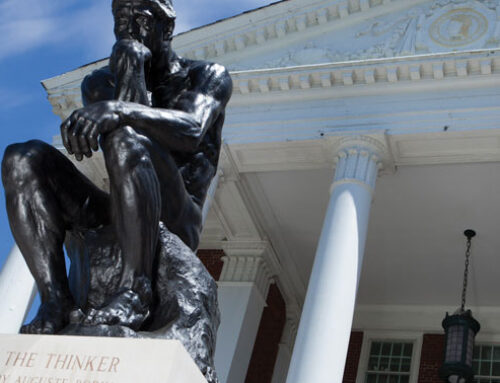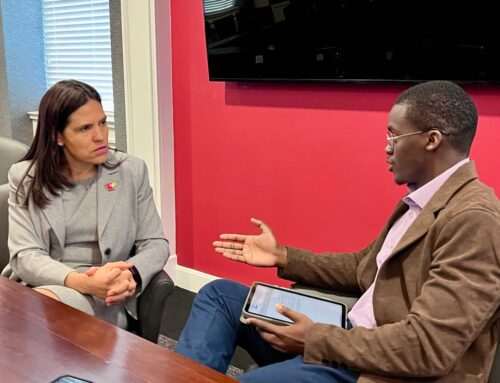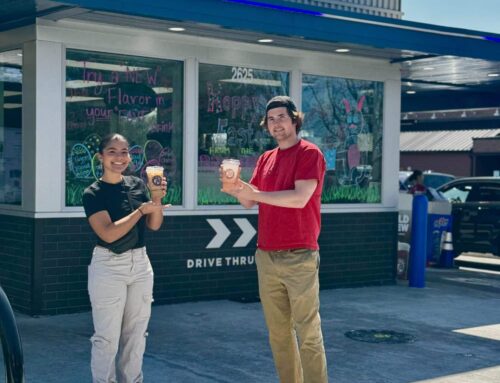It’s a few minutes past 7 p.m. on a blustery fall Wednesday. Students quietly bustle inside the Red Barn.
Three people paint a background black, finalizing the show’s simple set. Three guys move chairs onstage, while a fourth follows with a coatrack. Three women in black choral gowns aimlessly wander around the base of the stage, occasionally stopping to talk to a woman sitting in the middle of the action.
With her brown hair in a high ponytail, director Sarah Clark wears yoga pants and a hoodie: the unofficial uniform of a stressed woman. Her appearance is a metaphor for the night.
“It’s a little hectic,” she says. “Welcome to tech week.”
Within 24 hours, Clark and her cast, members of the student organization, Cardinals for the Appreciation for Musical Theater, will open their fall show, “I Love You, You’re Perfect, Now Change.” The Wednesday night rehearsal is their last chance to perfect the show.
It’s their first production since founder Spencer Scruggs graduated in May. By all accounts, Scruggs was the driving force behind the 4-year-old group. With a new cast of leaders, the fall show will determine if the group can stay afloat without their founder.
“CAMT is in a redevelopment this year,” Clark said. “We lost all of our big name players because they graduated or moved on. Everyone who was crucial to the group is gone.” As director, Clark guides the group’s leaders through the restructuring.
One of those leaders, senior education major Hannah Boyle, sits close by, clutching a travel mug and waiting for rehearsal to begin. After a brief stint as vice president of operations she became president, after the former president moved. Boyle referred to the transition as “pretty rocky.”
“I feel like we’re doing a really good job despite not knowing what we’re doing,” Boyle said. She’s kept in contact with Scruggs through Skype and phone calls.
“We’re going to do a cue to cue,” Clark says through a megaphone, referring to a rehearsal where the cast and crew move through a production’s lighting and sound cues.
Some cast and crew appear confused. “What is that?’ someone asks.
“It’s hell for you guys,” Clark replies.
Boyle has done theater before CAMT, but says about half of the cast are musical theater virgins who probably have never heard of a cue to cue prior to the production. One of the newbies is senior physical therapy major Will Smith.
Smith became involved when a friend brought him to auditions for last year’s production, “Hairspray.” He ended up auditioning and performing last year, making this his second year in musical theater.
“[CAMT’s] main mission is, one, to put on a good show and, two, introduce people to musical theater that haven’t really been in contact with it before,” Smith said. “That’s why it was such a great experience for me because it’s literally tailored for people who don’t have a lot of experience.”
On top of varying experience levels, the group has a variety of majors and accepts community members.
Smith said the cast was his favorite part. “You draw in such an eclectic group of people because anyone can do it. It’s not limited to U of L students, so you get to meet a lot of different people.”
Clark identifies herself as a “random community member that really liked the group.” Growing up in Owensboro, Kentucky, she did high school theater and continued through her college years at Bellarmine University, gaining directing experience.
Charity Means, the lone theater major in the cast, says she’s been acting on and off since childhood.
An hour after the 7 p.m. call time, rehearsal is about to begin. The cast puts body mics on while Clark talks through her megaphone. She explains the cue to cue process, saying they’re going to focus on transitions because they’re “uber scary.”
“We’re, like, a day behind,” Clark said. “Thursday opens do that.”
The cast climbs onstage for the opening number. Four guys and six girls. Clark says it isn’t the equal ratio required by the musical, but after a hectic audition process, it’s what she ended up with.
“The audition process was a little scary,” Clark said. “We didn’t have as many people as i thought we needed.”
After a rocky road of extra auditions, callbacks and finding replacements filling up the last weeks of August, rehearsals began in September. Due to the show’s sporadic style of vignettes, only a few people were needed at each rehearsal. Tech week rehearsals – typically the last rehearsals before opening night – required the full cast, plus a bassist and a pianist. The live musicians were just two of the expenses for the production.
“Musicians don’t work for free, ever, unless they suck,” Clark said, laughing.
“I won’t go too much into it, but the group does have some financial issues from the past that we’re trying to resolve,” Clark said. “We’re trying to keep things as inexpensive as possible.”
“Our rights were around $2,000, which isn’t terrible, but we don’t get a ton of money,” Clark said. “We had to bring in some extra lighting. We had to build sets. Printing was crazy expensive.”
The tight budget showed the next night, the awaited and somewhat feared Thursday opening night performance. Cast and crew milled about the Red Barn, opening doors, handing out programs and selling tickets.
Rows of plastic orange chairs line the front of the stage, reminiscent of those in elementary schools where the theater doubled as a gym or cafeteria. It felt like high school theater, but everyone was visibly older.
Clark sits on bench to the audience’s right. A friend comes up to her.
“Ready?” they ask.
“No,” Clark replies, one minute before curtain.
The show begins with a witty full-cast song about relationships. Everything is flowing smoothly until an overhead light burns out, leaving center stage dark.
Clark’s solution? Reblock the second act to keep the cast out of the shadows.
“I was like, ‘We can’t keep playing our scenes in the dark. We have to move people.’ I’m proud of them that they knew their show well enough that we could do that,” Clark said.
For the cast, the crowd’s approval was one of their favorite moments of the entire process.
“[The crowd] was completely appreciative. They were there just for us,” Smith said. “Seeing that kind of applause, that kind of reaction, knowing that people enjoyed what we did – that was my favorite part.”
“There was a lot of laughter and just hearing that feedback as an actor – a lot of adrenaline just courses through you,” Means said, smiling. “All of that work we put in is actually having an effect on the audience and we’re achieving our goal.”
The production ended in November, but the cast stays in contact through cast-bonding activities and planning for next semester’s production, most likely a musical revue.
Karaoke, ice skating and a Broadway jam session were examples of activities. “Without that, people would only see each other for the musical,” Means said.
“After last year’s number, no one wanted to hang out with anybody else. Everybody kind of wanted to take a break,” Clark said. “This year, everybody wants to hang out.”
“The cast dynamic this year is very different,” Means said. “This year is very peaceful. Last year, we had a lot of big personalities, a lot of clashing.”
“I feel like it’s super warm fuzzes all around,” Clark said. “Everybody likes everybody else. It makes for a better group dynamic when the shows go well.”
Finding rehearsal space. Sharing a technical director with another production. Actors dropping out. Money. Despite the obstacles, Clark thinks this production was smoother than past.
“We had several people say, ‘Didn’t you guys do Hairspray last year? Well, this was better.’ Oh, thank you,” Clark said with a laugh.
Photos courtesy Sarah Clark

